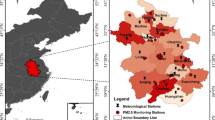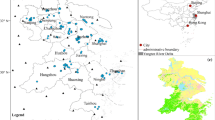Abstract
Due to recent development in different sectors such as industrialization, transportation, and the global economy, air pollution is one of the major issues in the twenty-first century. In this work, we aimed to predict ambient PM2.5 concentration using the prophet forecasting model (PFM) in Anhui Province, China. The data were collected from 68 air quality monitoring stations to forecast both short-term and long-term PM2.5 concentrations. The determination coefficient (R2), root mean squared error (RMSE), and mean absolute error (MAE) were used to determine the accuracy of the model. According to the obtained results, the predicted R, RMSE, and MAE values by PFM for PM2.5 were 0.63, 15.52 μg/m3, and 10.62 μg/m3, respectively. The results indicate that the actual and predicted values were significantly fitted and PFM accurately predict PM2.5 concentration. These findings are supportive and helpful for local bodies and policymakers to deal and mitigate air pollution problems in the future.
Access this chapter
Tax calculation will be finalised at checkout
Purchases are for personal use only
Similar content being viewed by others
References
Air Visual (2019) Airvisual–air quality monitor and information you can trust. Available at: https://www.airvisual.com/. Accessed 26 Aug 2019
Bhatti UA, Wu G, Bazai SU, Nawaz SA, Baryalai M, Bhatti MA, Nizamani MM (2022) A pre-to post-COVID-19 change of air quality patterns in anhui province using path analysis and regression. Pol J Environ Stud. https://doi.org/10.1007/s11356-020-08948-1
Bhatti UA, Yan Y, Zhou M, Ali S, Hussain A, Qingsong H et al (2021) Time series analysis and forecasting of air pollution particulate matter (PM2.5): an SARIMA and factor analysis approach. IEEE Access 9:41019–41031. https://doi.org/10.1109/access.2021.3060744
Bilal M, Mhawish A, Nichol JE, Qiu Z, Nazeer M, Ali MA et al (2021) Air pollution scenario over pakistan: characterization and ranking of extremely polluted cities using long-term concentrations of aerosols and trace gases. Remote Sens Environ 264:112617. https://doi.org/10.1016/j.rse.2021.112617
Deters JK, Zalakeviciute R, Gonzalez M, Rybarczyk Y (2017) Modeling PM2.5 urban pollution using machine learning and selected meteorological parameters. J Electr Comput Eng 1–14. https://doi.org/10.1155/2017/5106045
Garcia JM, Teodoro F, Cerdeira R, Coelho LMR, Kumar P, Carvalho MG (2016) Developing a methodology to predict Pm10 concentrations in urban areas using generalized linear models. Environ Technol 37(18):2316–2325. https://doi.org/10.1080/09593330.2016.1149228
Hasnain A, Hashmi MZ, Bhatti UA, Nadeem B, Wei G, Zha Y, Sheng Y (2021) Assessment of air pollution before, during and after the COVID-19 Pandemic Lockdown in Nanjing, China. Atmosphere 12:743. https://doi.org/10.3390/atmos12060743
Hasnain A, Sheng Y, Hashmi MZ, Bhatti UA, Hussain A, Hameed M, Marjan S, Bazai SU, Hossain MA, Sahabuddin M, Wagan RA, Zha Y (2022) Time series analysis and forecasting of air pollutants based on prophet forecasting model in Jiangsu Province, China. Front Environ Sci 10:945628. https://doi.org/10.3389/fenvs.2022.945628
He B, Heal MR, Reis S (2018) Land-use regression modelling of intraurban air pollution variation in China: current status and future needs. Atmosphere 9(4):134
Kamińska JA (2018) The use of random forests in modelling short-term air pollution effects based on traffic and meteorological conditions: a case study in wrocław. J Environ Manage 217:164–174. https://doi.org/10.1016/j.jenvman.2018.03.094
Liu N, Zhou S, Liu C, Guo J (2019) Synoptic circulation pattern and boundary layer structure associated with PM2.5 during wintertime haze pollution episodes in Shanghai. Atmos Res 228:186–195. https://doi.org/10.1016/j.atmosres.2019.06.001
Taylor SJ, Letham B (2017) Forecasting at scale. Am Stat 72(1):37–45. https://doi.org/10.1080/00031305.2017.1380080
Wang J, He L, Lu X, Zhou L, Tang H, Yan Y et al (2022) A full-coverage estimation of PM2.5 concentrations using a hybrid XGBoost-WD model and WRF-simulated meteorological fields in the Yangtze River Delta Urban agglomeration, China. Environ Res 203:111799. https://doi.org/10.1016/j.envres.2021.111799
Wu X, Guo J, Wei G, Zou Y (2020) Economic losses and willingness to pay for haze: the data analysis based on 1123 residential families in Jiangsu Province, China. Environ Sci Pollut Res 27:17864–17877. https://doi.org/10.1007/s11356-020-08301-6
Ye Z (2019) Air pollutants prediction in shenzhen based on arima and prophet method. E3S Web Conf 136:05001. https://doi.org/10.1051/e3sconf/201913605001
Zhai S, Jacob DJ, Wang X, Shen L, Li K, Zhang Y et al (2019) Fine particulate matter (PM2.5) trends in China, 2013-2018: separating contributions from anthropogenic emissions and meteorology. Atmos Chem Phys 19:11031–11041. https://doi.org/10.5194/acp-19-11031-2019
Author information
Authors and Affiliations
Corresponding author
Editor information
Editors and Affiliations
Rights and permissions
Copyright information
© 2023 The Author(s), under exclusive license to Springer Nature Singapore Pte Ltd.
About this paper
Cite this paper
Hasnain, A., Hashmi, M.Z., Nadeem, B., Nizamani, M.M., Bazai, S.U. (2023). Ambient PM2.5 Prediction Based on Prophet Forecasting Model in Anhui Province, China. In: Anwar, S., Ullah, A., Rocha, Á., Sousa, M.J. (eds) Proceedings of International Conference on Information Technology and Applications. Lecture Notes in Networks and Systems, vol 614. Springer, Singapore. https://doi.org/10.1007/978-981-19-9331-2_3
Download citation
DOI: https://doi.org/10.1007/978-981-19-9331-2_3
Published:
Publisher Name: Springer, Singapore
Print ISBN: 978-981-19-9330-5
Online ISBN: 978-981-19-9331-2
eBook Packages: Intelligent Technologies and RoboticsIntelligent Technologies and Robotics (R0)




